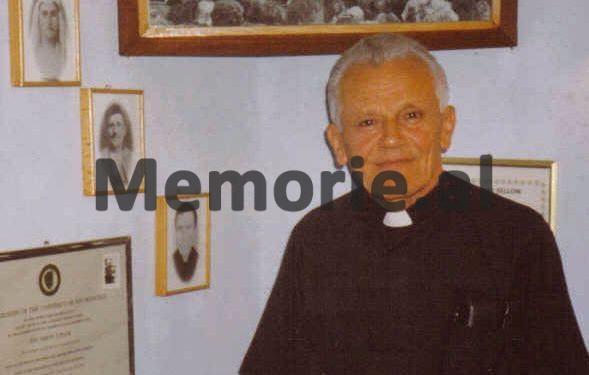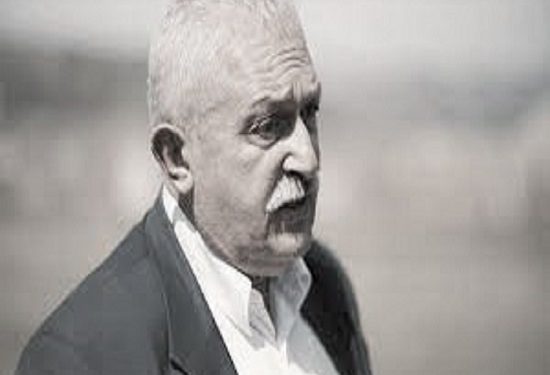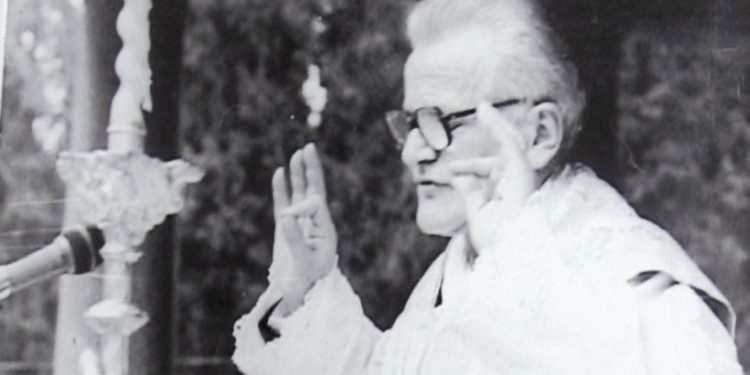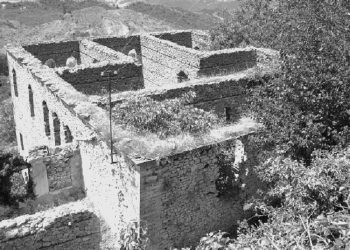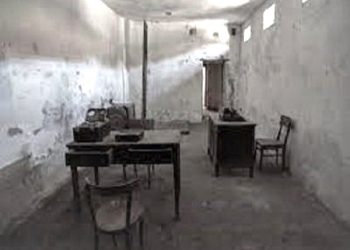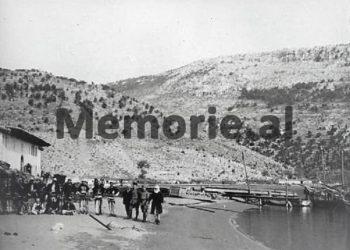By Marcel Hila
Second part
Memorie.al/ I remember how the Church of Our Lady of the Rosary was closed here in Shkodër. It was the last one left in service, since their closure began, after Enver Hoxha’s infamous speech on February 6, 1967. In those days and following, the tsunami began. They all locked, one by one. At that time I was a five-year-old child. This event, which had never happened before, created a great shock. The elderly, friends and acquaintances, mourned and were scandalized. War had been declared against God. “How far does the courage of this monster go?” – the terrified people asked under the sound!
Continues from last issue
This seems to be a convoluted act of God, but it is simple. As hidden, it does not appear; and as a patient, he gives time to the wicked to do evil. Monsters create in themselves the idea that they are invincible and that nothing can find them; but they are wrong. They seek to take over places, people, states, societies; it seems as if nothing stands in their way. But when they remember that they have all the power in their hand, when they have done what they wanted, then, the invisible one raises his head and overthrows them, He, the patient one, comes out, and with terrible anger, sinks them and wipes them off the face of the earth.
Everything he let go, he takes back in his hand, but also much more. A question naturally arises: did they succeed in eradicating the religious feeling of the society? No! The latest statistics of the Institute of Statistics showed that after so many long years of official, violent and programmed atheism, 90% of the Albanian population declared that they believed in God. We were the new champions in Europe. What a waste for those who spent time and large sums of money to lay, to plant in people’s hearts the idea that the great God does not exist.
But I want to mention another way of God’s action. In fact, his ways, as this prophet Isaiah says again, are endless; for example, stigmatization. What is this? They are wounds that appear on the body of his chosen ones. St. Francis of Assisi kept them in his body for two years and suffered a lot from the pain he experienced, Catherine Emmerich, for years and long years, with extraordinary pain in the head, with the blood flowing non-stop from the wounds of his hands and legs, and tied them with bandages; likewise Tereza Nojman, who was filled with blood that drained from the wounds of the crown of thorns and that this blood flowed from her eyes, down her cheeks, from her hands and feet. But we also know the case of the famous Saint Pio from Petralcina, who kept his wounds full of pain for fifty years. Why am I mentioning this way of action of Jesus with his believers? Because it is one of the ways in which He shows his likeness to someone, by sealing on their body the signs of the suffering he suffered.
And naturally the question arises: Can He act like this, leaving his likeness even to a city? I say yes. Since his ways of action are countless. I think he has shown this with Shkodra, our city. In 2018, I visited Israel, including Jerusalem. There is the courtyard of Pilate, where Jesus was beaten; Lysostros, the place where Pilate tried Christ and sentenced him to death; Golgotha, the place where He was crucified as well as nearby, the tomb where He was buried. Shkodra came to mind, where the Department of Internal Affairs was the place of torture, like Pilate’s Court; The court of Shkodra, the place where death sentences were given and the cemetery wall, the place of shootings and the area nearby, the place of burials. So far the comparison is clear and convincing.
But there is more to it than that; Shkodra is not the only one that resembles Jerusalem for the place of torture, death sentences and burials. There must have been other places where cemeteries were used for executions. Look at the painting “Shooting” by Francisco Goja. There it can be seen that people are being killed near the wall of a cemetery. But what is special about Shkodra? In what does it resemble Jerusalem, according to a way of God’s working? Here: in Jerusalem, three days after Christ was buried, he resurrected, came out of the tomb, and escaped death. In Shkodër, from a cemetery, where people were unjustly killed, where the servants of Christ were shot, where the martyrs died, on November 4, 1990, the Albanian miracle happened: the resurrection happened, the Church and the murdered society came out of the grave.
There is not a second case in the world where the religious and social revival of a nation has come from a cemetery. Only Jerusalem and Shkodra have this. To this city, Jesus put the seal of likeness, on this date, bringing faith and social life out of the grave. This is this special way of action of this secret and patient God, of this God who leaves his wounds as a sign of truth, of God who leaves traces of resurrection where He wants and how He wants. He came out of a cemetery then, there, Albania also came out in freedom from a cemetery here.
November 4 is the dividing line between life and death, it is the first Easter after the dead, the first ray, the dawn of the new reality we live in today, the crossing of the Red Sea from the slavery of the pharaoh to the land of freedom.
That gigantic mobilization, the killing of fear, the unparalleled enthusiasm prepared the way for political pluralism and the democratic movement, fueled popular enthusiasm, fertilized the situation everywhere in the country. Albania and the whole world found out. It was said: “Something big has happened there, it has exploded, and the sun is coming out”! We must have no illusions: Democracy did not come as a calculated political action, as a weighed and consulted decision of the leaders. It was not the political factor, the communists they didn’t even want this, which made the democratic opening possible, but the opposite: it was the resurrection mass which made possible political action and consequently democracy. It was the explosion of this bomb, the wave of which shook everything, hit the regime and collapsed the dictatorship. It didn’t happen where freedom would explode from a mass in the cemetery. Those who have not understood the effect of Easter, have the opportunity to learn.
But let’s go back to the wall of blood, or as it was said, the wall of Vorre t Rrmaji. Who are the ones who ended up being torn apart by bullets? Massacred, killed and put in shallow pits, covered trampled and go where the waters of the first rains take them with them? The entire Albanian society ended there, the whole of Albania rotted there.
Who shot them, who killed them?
They were killed by the hatred of communism. In order: there, the first is the Catholic Church, there are also simple people of other faiths, people with values and virtues, who for faith in God, faith in their ideas of freedom and progress, are the enemies of the regime of young man who kills them; there is the old political class, there is the youth that does not accept communist crime. There is knowledge, culture, owners, and aristocracy. It is all of Albania that counts, the backbone of the nation. We said that the hatred of communism killed them.
Where does this hatred come from? Is it created on the spot in a few years and, like a noisy avalanche, precipitates as if coming from the mountains and falls on the innocent or is it a long production in time? Communism is a poisoned stew, slowly formed over centuries. It begins as hatred and ends as such. The Brazilian philosopher, Plinio Correa de Olivea, shows the birth stages of what he calls revolution. He talks about four stages. Communism was the third. The fourth is still in operation. We are analyzing the first three.
The first: It was the Protestant hatred of the Catholic Church. The separation from Rome, the refusal to recognize the dogmas, the denial of the sacraments, the ignorance of the saints, the denial of the Eucharist and Mary, the ignorance of the Papacy, created the great schism. Europe was divided in two. Only a great hatred could do what happened. It is said that from that moment on, Protestants know only Christ, but not the Church.
The second phase: It starts with the Enlightenment and the French Revolution. The Enlightenment brought faith in reason and no longer in religion, it proposed agnosticism. The belief of the Enlightenment is summed up in the postulate: a higher Being can exist. Consequence: Christ no, but the Being Yes. In the political field, again hatred towards the Catholic Church, accused of being a parasite, as the one that supports fraud and exploitation. It must disappear from the face of the earth. He did the crusades, he killed…! This time, hate becomes a program. The revolution establishes the disappearance of the old order, even of the aristocracy. The snapping of heads begins. The guillotine starts working. It is the first time in history that we are dealing with civil war. Why should these be eliminated? Because they are against the revolution. The revolution is made by the people, the great masses and those who stand up against the will of the people.
Here is now the third phase: In the communist revolution. Hatred for the Catholic Church reaches its peak. Enlightenment agnosticism turns into atheism. Now there is no Supreme Being to believe in, but none. The sky is empty. Only historical materialism is true science. So war every faith. Atheism turns into a political program. Only man is the master of the earth. Whoever defends the faith is an enemy of the human mind, which must be freed from opium with everyone. And the greatest hatred is again directed against the Catholic Church, as the center of obscurantism and reaction, as fanatical and backward. It must be plucked from the face of the earth. The state undertakes this task. It is the first time in history. The hatred against the old order continues even more fiercely, as the French revolution has carried on. In Russia, the entire aristocratic class was annihilated. The royal family was killed and burned with gasoline; nobles and nobles were annihilated by firing squads and sent to prisons.
The French revolution has no prisons, but only the guillotine, while the communist revolution creates many prisons, the gulaks, as Solzhenitsyn said, giant archipelagos, in the steppes, in Siberia, in Akku, in Kolyma, with sentences of many, many years, with the Code Terrible criminal. Communism created the political prison. He is the inventor and the implementer of it, the likes of which the world had never seen. Communism added the dose of hatred and, in addition to the clergy, the categories of dangerous enemies are artists, intellectuals, landlords, thinkers, feudal lords, kulaks, industrialists, former revolutionaries, idealists, dreamers, liberals, aristocrats, rich people, but also musicians. , accused as saboteurs of reforms, obstacles to the formation of collective farms, nationalizations. All of these either went before the firing squads, or became the inhabitants of those terrible, huge silos. The communist revolution dispossessed the people. He robbed his people’s property by law and program. This act of hate had never been seen in history.
Communism was a program of hatred that came to Albania from the Russian steppes. Imported hate. Hate of the last quality, updated, we would say today. Let’s return once again to the back wall of the Rrmaji Cemetery. Who was killed in that place? Those whom communism hated. First, the Catholic Church. Communism kills in its own people. As in Russia, the people of the old regime, as in Russia, the intellectuals, but also the young politicians, who do not support the program of communism, but hope and work for a free and democratic Albania? The narrow-minded aristocracies of this country, the big families, the heads of the tribes, and patriots who are not internationalists were also killed. Tell me which historical hatred was not carried over from the centuries, did not pass into the bed of Russian communism, was not imported here and was not put into action! Peasants, poor people, and learned people who enlighten the mind with ideas and ignite hearts with the flame of the ideal took the bullets.
The rich class, previously dispossessed, was killed there, every bearer of the dream of freedom is killed there, it is the place of execution of poets and writers, philosophers and soldiers, and every European was drowned in spirit and mind. What does European mean? Let’s first answer the question: what is Europe? Europe is a set of traditions, institutions, laws and culture, built and formed to implement the order of the Gospel: love man because he is worth a lot, because God became man and died for him! Europe is care and love for man in institutions and culture, science and arts. Europe is therefore ideal, because it is the expression of love for man. The European is the bearer of this ideal. That idealist was killed there, he died there. Hate was killing him. They were killing Europe, as they had previously declared it an enemy. Why? Because Europe was a creation of love, not hatred, the fruit of the Gospel. Albanian Europe could not escape the hatred of the revolution.
That is why the communist hatred cooked in Lutheran Germany, passed to Masonic France, took place in musical Russia and arrived from the cold steppes to us. Here he got mixed up with the vices of this land, first and foremost: deep ignorance, inseparable and incurable Haji-Qamilism. Let’s go back to the bright dates November 4 and 11, let’s go to the Rrmaji Cemetery. Everyone came out of the graves in these days of resurrection. The Catholic Church came out, but the defenders of the right to believe came out, the poets and writers who were killed and with lost bones came out, the patriots, the rich class, the military and courageous politicians, they all came out. The entire slaughtered Albanian society came out.
This was done by its main protagonist, Dom Simon Jubani, the real hero, the pearl cooked slowly, quietly, in the shell of isolation, away from the eyes of people, in the prison of Burrell. He, sentenced to twenty-six years, carried the hero within himself. Lived miraculously saved him exactly for this day, without him even knowing how. His soul and mind were waiting for this event. He was the prophet of this day. He did not know that he was appointed for this task. But why was he put in charge? Quite simple: nature ordered him from the hero he had. It was the great chosen one, the Moses of that day, the deliverer.
The hero lived in him, not the philosopher. Who is the hero? The one who shows courage and selflessness, the one who sacrifices himself with free will to realize an ideal, the one who considers death from this action, the one who journeys irrevocably towards great dangers, without regret and without looking back, when can even avoid them. The hero is the one who goes bravely on his own, without fear, even when everything is against him, he challenges and attacks evil. When everyone trembles with fear, when nothing sucks, when there are many who would like to, but cannot take it, when, as Jesus says, the spirit is ready, but the flesh is weak, that’s when the hero attacks alone. No hesitation, no doubt. This was Dom Simoni. This merit will never be denied for any reason. He was, as Goethe said: “The right man, at the right time”. It came from great suffering, to show people that the truth does not die, it is not defeated. He wanted to do this with the sacrifice of his life. Dom Simoni is a hero.
This was no accident either. Dom Simon, if we see it as it was spoken at the beginning, was part of God’s plans. Christ, through him, would show that he exists, even though he had remained hidden when the tragedy happened, God, through dom Simon, abandoned his patience, went to the battlefield and won. God, through dom Simon, and the boys who protected and accompanied him, showed that he was giving Shkodra the trace of likeness, God, through dom Simon, was reviving a nation from the graveyard. Through him, Jesus was being resurrected in this land. The brave boys and men who protected, protected and helped him were all part of God’s plans.
But who are these? I am saying it without fear and with my mouth full: they were the apostles. Christ told his disciples that you will do greater things than I have done. What made them bigger? I say it without fear: they did not run away, they did not abandon Dom Simon. They stayed at the graves, alone, unarmed, defenseless, when they could be killed, when they too could find death from the wounded beast, which five months later killed four young men and wounded 96 others. They did not let go of Dom Simon, the great missionary, out of fear. Jesus’ apostles, all of them, deserted him that night, in Gethsemane, when the soldiers came to arrest him. While these men, who we have here, were more determined than the apostles. When Saint Peter assured Jesus that he would stay with him even if he had to die, Jesus turned and said to him: “When the rooster crows twice, you will have denied me three times and all of you will forsake me”!
But that didn’t happen to our heroes who thankfully have them all here. These are heroes too. These too challenged evil, they considered the danger of life, and these too had nothing but life and decided to sacrifice it. Not only should the city with generations, but Albania as a whole be grateful to them, forever. The question naturally arises? Who called them? Dom Simon? No! They were the ones who went and called Dom Simon. They were the ones who set the world in motion. They were the ones who were not pushed by anyone, but they felt that the time had come.
What time The time of God’s triumph. That is why the apostles of that day were the weapons of Jesus Christ, the knights of his victory. It was not the interest, even if it was far, nor the money, which no one had, nor the power, what power? Not even the promises… from whom, but it was a big, deep call that came from his heart, it was the call of God, the call of Jesus Christ, the call of life, the call to mission. They were Nicodemus and Joseph of Arimathea, the special ones called on the day of the resurrection of murdered Albania, the resurrection of slaughtered Albania.
That blow had the force of an atomic weapon. Its first wave spread to the city and its surroundings, passed to other cities, arrived in the capital. Immediately, in the following days, the mosque was opened in Shkodër. The effect was felt. Preparation for the political revival began. This here, begat that there. The wave of revival of the Rrmaji cemetery gave birth to the Student Movement. Albania was getting ready to get out of misery and suffering, from oppression and slavery.
And the white days could not come, the days that the stigmatized German, Tereza Neuman, told Vincenc Prendushi, when he visited her in 1932, and prophesied endless suffering for our land. “You will live a terrible ordeal, but after all these dark days pass, white days will come for your country as well.” These are the heroes of these days, of the dawn, of the first rays of the sun of victory.
These boys and men reminded us that Albania has braves and heroes, that this land continues to give birth to such and for this we should be grateful to God, who brings them out in difficult times, to tell us when it seems to be hidden, He acts through them, and when he seems to be patient, he puts a limit to his divine patience by bringing these into the field of battle for victory.
And here is the last word: Catherine the Great of Russia said that only when the protagonists of the events have died, when the blood has cooled, when the emotions have died down, when the mind sees clearly and draws the correct conclusion, when time has given its verdict, which is infallible, then a monument should be erected for the heroes. I think so, too. Dom Simon Jubani, the boys and men who called him and accompanied him, protected him, guarded him and passed him on, deserve a monument in the middle of Shkodra, the biggest one. Memorie.al





